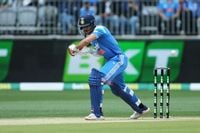The much-anticipated India vs Australia ODI series kicked off in dramatic fashion at Perth’s Optus Stadium on October 19, 2025, with rain clouds, debut milestones, and a spirited Australian chase shaping a contest that cricket fans won’t soon forget. In a match punctuated by four rain delays and a controversial use of the DLS method, Australia seized a 1-0 lead in the three-match series, defeating India by seven wickets in a game that was as much about adapting to circumstances as it was about skill.
When the teams strode onto the field, the narrative was already thick with intrigue. Rohit Sharma, appearing in his 500th international match, joined forces with Virat Kohli for the first time since India’s triumphant Champions Trophy campaign in March. The duo, both having stepped away from T20Is and Tests, were under the microscope, with critics and fans alike eager to see if they could still deliver on the big stage. Adding another layer to the occasion, 25-year-old Shubman Gill made his debut as India’s ODI captain, taking over from Rohit and tasked with leading a side in transition.
Australia’s skipper, Mitchell Marsh, won the toss and elected to bowl first, a decision quickly vindicated by his bowlers. The match, initially scheduled for 50 overs per side, was repeatedly interrupted by rain, ultimately being reduced to just 26 overs each. The DLS method, long a subject of debate in the cricketing world, was called into action after four separate rain delays, setting the stage for a contest where every run and every over would carry extra weight.
India’s innings never really got off the ground. The top order crumbled under relentless Australian pressure, with Rohit Sharma, Virat Kohli, and Shubman Gill all departing inside the PowerPlay, none managing to reach double figures. It was a nightmare start for the Men in Blue, with the scoreboard reading a paltry 25/3 at one stage—their lowest ever in an ODI PowerPlay involving this trio. As Australia’s bowlers, led by Josh Hazlewood and Mitchell Starc, kept the pressure on, Shreyas Iyer and Axar Patel attempted to rebuild but were thwarted by sharp fielding and disciplined lines.
KL Rahul offered a glimmer of hope with a quick-fire cameo, launching back-to-back sixes and finding the boundary with some aggressive strokes. Axar Patel, too, showed intent, clubbing a pair of boundaries in a rare flourish. But wickets continued to tumble, and India’s lower order faltered under the pressure. Debutant Nitish Kumar Reddy, handed his cap by Rohit at the same venue where he made his Test debut, managed a spirited finish, lofting two big sixes in the final over to push India to 136/9 in their allotted 26 overs. However, the DLS method revised Australia’s target down to 131, a figure that would soon seem well within reach.
As the teams switched sides, the debate over the fairness of the DLS method was reignited by none other than Indian legend Sunil Gavaskar. Speaking to India Today, Gavaskar didn’t mince words: “People don’t understand the method despite its being used for a long time. There was an Indian who introduced the VJD method, which is better for both teams. The BCCI uses the VJD method in domestic cricket. The ICC need to look at that as a system is needed which is fairer to both teams when rain impacts the game.” His comments echoed the sentiments of many fans who felt the revised target gave Australia a clearer path to victory.
Australia’s chase began with a flurry of boundaries. Travis Head got things rolling, but it was Mitchell Marsh who truly anchored the innings. Marsh, who would later be named Player of the Match, played with composure and controlled aggression, finishing unbeaten on 46 off 52 balls. The chase wasn’t without its moments of drama—Arshdeep Singh struck early to remove Head, and Axar Patel and Washington Sundar chipped in with wickets to keep India in the hunt. There were flashes of brilliance in the field as well, with Mohammed Siraj saving a certain six with an acrobatic leap at the boundary and KL Rahul nearly pulling off a spectacular diving catch.
Josh Philippe, Australia’s wicketkeeper-batsman, played a brisk knock of 37 off 29 balls, peppered with boundaries and a pair of sixes, before falling to Sundar. Marsh’s partnership with Philippe and later with Matt Renshaw ensured Australia never lost control of the chase. Renshaw survived a dropped catch and added crucial runs, while Marsh’s three sixes kept the required rate in check. Australia crossed the finish line with 29 balls to spare, sealing the win at 131/3 in 21.1 overs.
At the post-match presentation, Marsh acknowledged the unusual circumstances: “It was [a strange game]. Weather played a part. Good to get a win. Always nice to win at home. I love playing here.” He praised the young players in the squad, particularly Josh Philippe, saying, “He came in and made it easy! The young guys coming in, you want them to come in and enjoy. I said to the group that you don’t get to play ODIs in front of big crowds often, so go out and enjoy.”
On the Indian side, Shubman Gill reflected on the early collapse and the lessons learned: “Never easy when you lose three wickets in the powerplay, you are always trying to play a catch-up game. There were a lot of learnings and positives as well. Defending 130 in 26 overs, we took the game pretty deep so we’re satisfied with that. We’re very fortunate that wherever we play, fans turn up in huge numbers.”
Despite the setback, Sunil Gavaskar remained optimistic about India’s prospects in the remainder of the series. He expressed hope that Rohit Sharma and Virat Kohli would find form soon, stating, “India is a good team and won the Champions Trophy a few months ago. Don’t be surprised if Rohit and Virat score big in the remaining two matches. They are playing after a long time, and they need practice. Once they are back at their best, India will score over 300 runs.”
The result means Australia take a 1-0 lead in the series, with two matches still to play. For India, the focus will be on regrouping and finding their batting rhythm, particularly with the 2027 World Cup in South Africa looming on the horizon. As for the DLS debate, it’s clear that rain-affected matches will continue to spark discussion about fairness and competitive balance.
With both teams boasting plenty of talent and storylines aplenty—from debutants to returning legends—the stage is set for a fiercely contested series. All eyes now turn to the second ODI, where India will look to bounce back and Australia will aim to maintain their momentum in front of their home fans.

